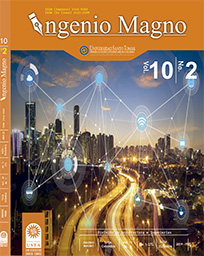Evaluation of approximate models for the design of automatic control in open channel irrigation systems
Main Article Content
Abstract
Downloads
Article Details
DECLARATION OF ORGINIALITY OF SUBMITTED ARTICLE
With this document, I/We certify that the article submitted for possible publication in the institutional journal INGENIO MAGNO of the Research Center Alberto Magno CIIAM of the University Santo Tomás, Tunja campus, is entirely of my(our) own writing, and is a product of my(our) direct intellectual contribution to knowledge.
All data and references to completed publications are duly identified with their respective bibliographical entries and in the citations thus highlighted. If any adjustment or correction is needed, I(we) will contact the journal authorities in advance.
Due to that stated above, I(we) declare that the entirety of the submitted material is in accordance with applicable laws regarding intellectual and industrial property, and therefore, I(we) hold myself(ourselves) responsible for any complaint related to it.
If the submitted article is published, I(we) declare that I(we) fully relinquish publishing rights of the article to the University Santo Tomás, Tunja campus. As remuneration for this relinquishment of rights, I(we) declare my(our) agreement to receive two (2) copies of the edition of the journal in which my(our) article appears.
References
Organización de las Naciones Unidad ONU, (2019). Perspectivas de la Población Mundial 2019, from. https://population.un.org/wpp/.
Instituto de Hidrología Meteorología y Estudios Ambientales IDEAM, (2018). Reporte de avance del Estudio Nacional del Agua 2018, Colombia.
Instituto Geográfico Agustin Codazzi IGAC, (2017). Producción agropecuaria en los grandes Distritos de riego de Colombia ha sido improvisada: IGAC, from. https://igac.gov. co/noticias/produccion-agropecuaria-en-los- grandes-distritos-de-riego-de-colombia-ha-sido-improvisada.
Pedroza, E. y Hinojosa, G. (2014). Manejo y distribución del agua en distritos de riego. Breve introducción didáctica. México.
Chow, V. T., Maidment, D. R. y Mays, L. W. (1994). Applied Hydrology, Ed. McGraw-Hill Interamericana S.A.
Rijo, M. y Arranja, C. (2010). Supervision and Water Depth Automatic Control of an Irrigation Canal, J. Irrig. Drain. Eng., vol. 136, no. 1, pp. 3–10, Jan.
Nguyen, L. D., Prodan, I., Lefevre, L. y Genon- Catalot, D. (2017). Distributed Model Predictive Control of Irrigation Systems using Cooperative Controllers, IFAC-PapersOnLine, vol. 50, no. 1, pp. 6564–6569, Jul.
Horváth, K., Galvis, E., Gómez, M. y Rodellar, J. (2015) New offset-free method for model predictive control of open channels, Control Eng. Pract., vol. 41, pp. 13–25.
Horváth, K. (2013). Model Predictive Control of Resonance Sensitive Irrigation Canals,University Of Catalonia Barcelona Tech.
Bolea, Y., Puig, V., y Grau, A. (2014). “Discussion on Muskingum versus integrator-delay models for control objectives,” J. Appl. Math.
Overloop, P. J., Clemmens, A. J., Strand, R. J., Wagemaker, R. M. J., y Bautista, E. (2010). Real-time implementation of model predictive control on maricopa-stanfield irrigation and drainage District’s WM canal, J. Irrig. Drain. Eng., vol. 136, no. 11, pp. 747–756.
Segovia, P., Rajaoarisoa, L., Nejjari, F., Puig, V. y Duviella, E. (2017). Decentralized control of inland navigation networks with distributaries: application to navigation canals in the north of France, in proceedings of the 2015 American Control Conference (ACC), May.
Clemmens, A. J., Kacerek, T. F., Grawitz, B., y Schuurmans, W. (1998). Test Cases for Canal Control Algorithms, J. Irrig. Drain. Eng., vol. 124, February, pp. 23–30, 1998.
Clemmens, A. J., Tian, X., Overloop, P. J., y Litrico, X. (2017). Integrator delay zero model for design of upstream water-level controllers,”J. Irrig. Drain. Eng., vol. 143, no. 3.
Schuurmans, J. (1997). Control of Water Levels in Open-Channels, Delft University of Technology.
Litrico, X., Malaterre, P. O., Baume, J. P., Vion, P.-I. y Ribot-Bruno, J. (2007). Automatic tuning of PI controllers for an irrigation canal pool, J. Irrig. Drain. Eng., vol. 133, no. 1, pp. 27–37.
Overloop, P. J., Miltenburg, I. J., Bombois, X., Clemmens, A. J., Strand, R. J., Giesen, N. C. y Hut, R. (2010) Identification of resonance waves in open water channels, Control Eng. Pract., vol. 18, no. 8, pp. 863–872.
Litrico, X. y Fromion, V. (2004). Simplified Modeling of Irrigation Canals for Controller Design, J. Irrig. Drain. Eng., vol. Volume 130, no. Issue 5, p. Pages 373-383.
Gerald T McCarthy. (1939) The unit hydrograph and flood routing. U.S. Engineer Office, Providence, R.I..
Chow, V. T. (1959). Open-Channel Hydraulics. New York: McGraw·Hill Book Company INC.
Gill, M. A. (1978). Flood routing by the Muskingum method,J. Hydrol., vol. 36, no. 3–4, pp. 353–363, Feb. 1978.
Das, A. (2004). Parameter Estimation for Muskingum Models, J. Irrig. Drain. Eng., vol. 130, no. 2, pp. 140–147, Apr.
Cunge, J. A. (1969). On The Subject Of A Flood Propagation Computation Method (Musklngum Method), J. Hydraul. Res., vol. 7, no. 2, pp. 205–230, Jan.
Conde, G. J., Quijano, N. y Ocampo, C. (2019), Modeling and Control of Interacting Irrigation Channel, IEEE 4th Colombian Conference on Automatic Control. Colombia, Medellin.
United States Environmental Protection Agency EPA. (s,f). Storm Water Management Model (SWMM). from. https://www.epa.gov/water-research/storm-water-management-model-swmm#tab-3.

